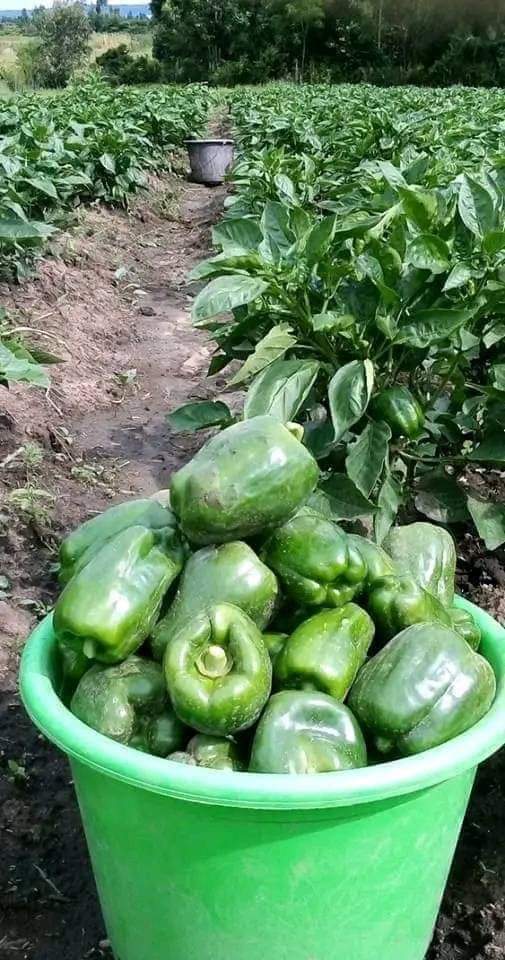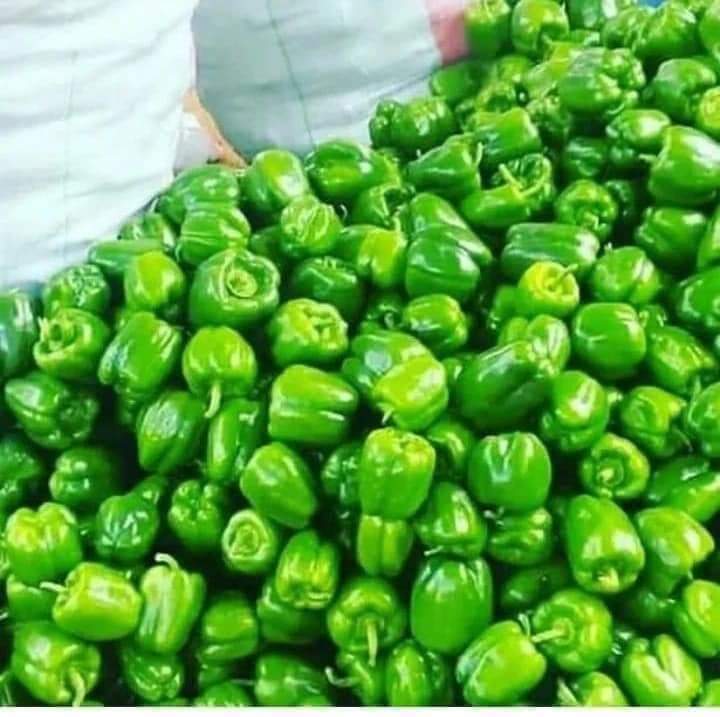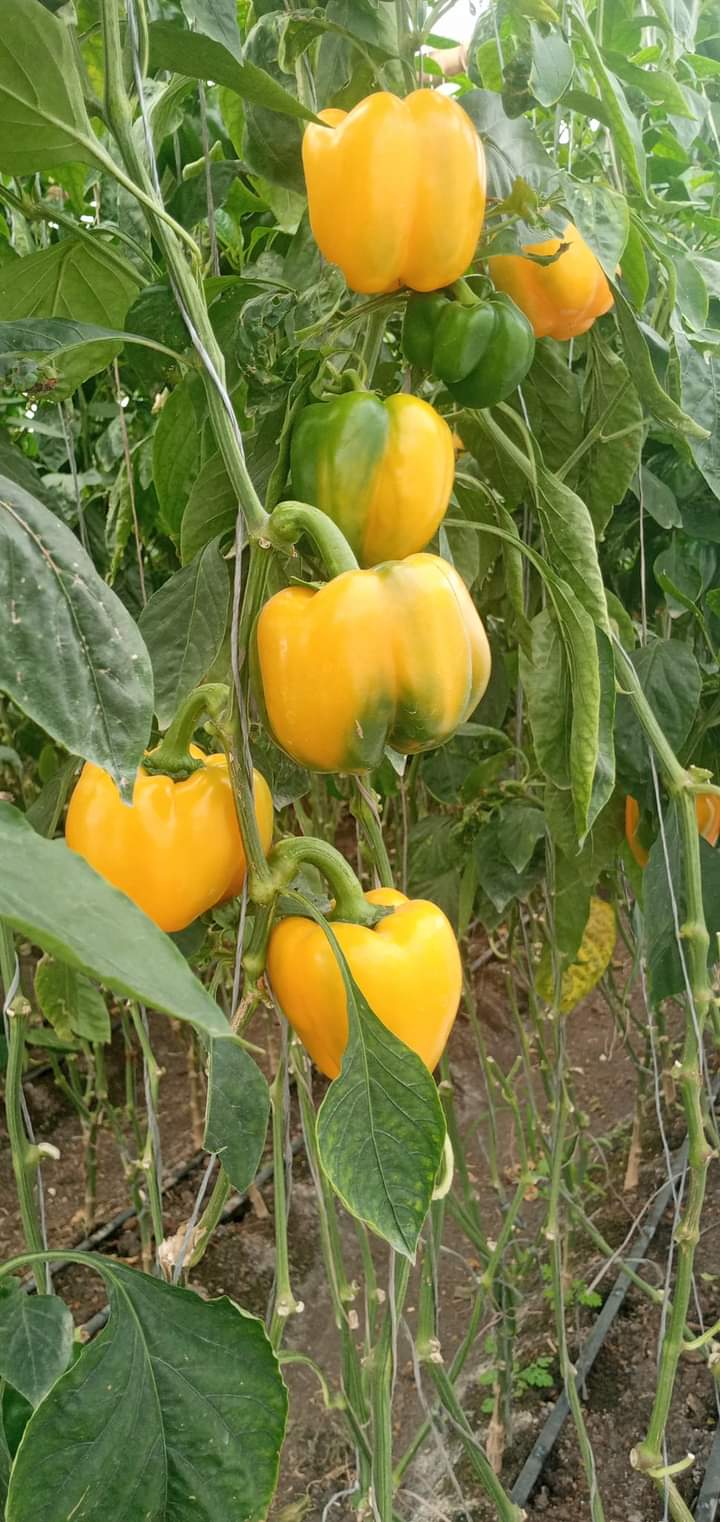Often referred to as “pilipili hoho” in Kenya, capsicum holds a prominent place in Kenyan cuisine, adding flavor and spice to a variety of dishes. Known internationally as bell pepper, sweet pepper, or simply pepper, it is a cherished ingredient in many culinary traditions.
Originating from Mexico, Central America, and northern South America, pepper seeds found their way to Spain in 1493, eventually spreading across Europe and Asia.
The term “capsicum” originates from the genus of flowering plants encompassing the fruits we commonly know as “bell peppers” or “peppers.” Its etymology traces back to the Greek word “kapto,” meaning “to bite” or “to swallow.”
Environmental Conditions for Capsicum Cultivation

Capsicums thrive in both outdoor and indoor (greenhouse) environments, depending on the variety. These crops prefer slightly warmer temperatures, with optimal conditions for fruit setting ranging between 16-21°C. For optimal fruit development, night temperatures should be around 15–17°C, with daytime temperatures ranging from 24–30°C. Frost is detrimental to capsicum plants, leading to small, hard, and malformed fruits with potential growth cracks during cold weather.
Ideal growing conditions include altitudes of up to 2,000 meters above sea level, with an annual rainfall of 800-1200mm. Well-drained soils rich in nutrients, with a pH range of 5.5–6.5, are favorable for capsicum cultivation.
Transplanting
- Prepare the nursery bed, approximately 1 meter wide and the required length.
- Drench the soil with a mixture of:
- 10 g of LOYALTY® 700WDG
- 100 g of PYRAMID® 700WP
- 20 ml of OPTIMIZER® in 20 liters of water. This mixture controls soil pests and diseases, provides nutrients, breaks seed dormancy, and promotes uniform germination.
- Sow seeds at a depth of about 2 cm and lightly cover them with soil.
- Cover the nursery bed with a thin layer of mulch.
- Water the nursery bed.
Tips:
- Seeds typically germinate within 2 to 3 weeks depending on the variety and ecological conditions.
- Provide shade to protect seedlings from direct sunlight and strong winds.
- Ensure proper nutrition for strong and healthy seedlings, promoting a healthy crop upon transplantation.
- To mitigate transplanting shock, spray seedlings with OPTIMIZER at a rate of 10 ml per 20 liters of water.
Transplanting:
- When seedlings reach 4-5 leaves, usually around 6 to 7 weeks after sowing, they are ready for transplanting.
- To harden young plants, reduce irrigation frequency a week before transplanting and withdraw shading. Before lifting seedlings, irrigate the nursery bed.
Procedure:
- Create raised or sunken beds on prepared land.
- Mix soil with manure and DAP. For improved nutrient uptake and root development, mix 1 kg of HUMIPOWER® with 50 kg of DAP and/or 1 ton of manure.
- Irrigate beds for easy planting.
- Plant seedlings in beds with a spacing of 75 cm by 45 cm.
Tips:
- Transplant early in the morning, evening, or during dull weather.
- Only transplant healthy and robust seedlings.
Benefits

Capsicum offers more than just flavor enhancement in your dishes; it serves as a highly nutritious vegetable with a plethora of benefits for your body:
- Abundant in Vitamin A, B6, and C, vital for overall health.
- Packed with antioxidants, aiding in the maintenance of good health.
- Possesses anti-inflammatory properties, contributing to reduced inflammation in the body.
- Contains dietary fiber, promoting effective digestion.
- Provides potassium, assisting in the regulation of blood pressure levels.
Capsicum Varieties in Kenya
In Kenya, various capsicum varieties thrive, among which California Wonder, Green Bell, and Admiral stand out:
- California Wonder: This red variety is renowned for its classic appeal and high yield. Featuring large, thick-walled fruits, it begins as a vibrant green before maturing into a rich red hue.
- Green Bell: A popular green capsicum variety prized for its sweetness and juiciness, ideal for both salads and cooking. Known for its sizable fruits, it dominates Kenyan markets.
- Admiral: Syngenta’s signature yellow capsicum variety, often cultivated in greenhouses for optimal results. While suitable for outdoor cultivation, farmers have observed lower yields compared to greenhouse conditions, yet it remains a sought-after option.
Planting
Choosing an ideal location:
- Capsicum plants thrive in full sun, requiring a minimum of 6 hours of direct sunlight daily. Therefore, avoid areas shaded by trees or tall buildings. Also, refrain from planting in spots previously occupied by other Solanaceae family plants.
Soil preparation:
- Optimal growth occurs in fertile, well-drained soil. Enhance soil quality by incorporating compost or well-rotted manure based on soil test recommendations. Utilize raised beds to improve soil aeration and facilitate deeper root growth.
Transplanting seedlings:
- Acquire professionally cultivated seedlings from Richfarm Kenya Nurseries and transplant them into prepared plots. Maintain a spacing of 60cm between rows and 45cm between plants, equating to approximately 15,000 plants per acre.
Water management:
- Ensure consistent moisture levels for capsicum growth. Test soil moisture by firming it in your palm; if it sticks, it’s moist. Avoid overwatering to prevent root rot. Water deeply but infrequently, allowing soil to partially dry between watering sessions.
Fertilization:
- Capsicum plants demand balanced soil nutrients for robust growth. Incorporate manure during soil preparation for essential nutrient supplementation. Additionally, consider periodic application of slow-release or liquid fertilizers every 2-4 weeks, guided by soil test results.
Support provision:
- As capsicum plants can become tall and heavy with fruit, offer support like stakes or cages to prevent breakage and collapse.
Tip pruning:
- Encourage branching and increased fruit production by regularly pinching off the tips of capsicum plants.
Harvesting:
- Harvest capsicum when fruits reach full maturity, displaying vibrant color and firm texture. Utilize a sharp knife to cut fruits from the plant, leaving a small stem segment attached.
Maturity timeline:
- Capsicum typically matures within 2-3 months after transplanting seedlings, with variations depending on local climate and variety. Green varieties typically mature faster than red or yellow ones.
Capsicum Farming in Kenya: Pest and Disease Control
Pests:
Cutworms:
- Soft-bodied caterpillars that cut seedlings near the soil level, usually active during morning and evening hours.
- Control by drenching soil with PROFILE® 440EC (3 ml/L) or PENTAGON® 50EC (1 ml/L).
Thrips:
- Small, slender insects with fringed wings feeding on leaves, flowers, and fruits, causing distortion and stunted growth.
- Control with sprays of ALONZE® 50EC (5ml/20L), BAZOOKA® 18EC (0.5 ml/L), OCCASION STAR® 200SC (3 ml/20L), or DEFENDER® 25EC (2 ml/L).
Red Spider Mites:
- Tiny pests found under leaves, causing yellowing and curling. They spin protective silk webs.
- Treat using the same methods as for thrips.
Aphids:
- Light green, soft-bodied insects clustering on leaves and stems, causing wilting and distortion.
- Manage with sprays of KINGCODE ELITE® 50EC (0.5 ml/L), PENTAGON® 50EC (0.5 ml/L), or LEXUS® 247SC (8ml/20L). Control sooty mold with JAMBO CLEAN® (5 ml/L).
Whiteflies:
- White, winged insects sucking plant sap and excreting honeydew, leading to yellowing and leaf drying.
- Treat using the same methods as for aphids. Control sooty mold similarly.
Root Knot Nematodes:
- Microscopic parasites causing root swellings and plant stunting.
- Drench soil with ALONZE® 50EC (0.5 ml/L) or mix basal fertilizer with ADVENTURE® 0.5GR.
Diseases:
Damping-Off:
- Soilborne disease causing rot in seeds and seedlings.
- Control by drenching soil with PYRAMID® 700WP (5 g/L) and spraying crops with DOMAIN® 250EC (0.5 ml/L) or GEARLOCK TURBO® 250WP (25g/20L).
Anthracnose:
- Fungal disease resulting in sunken lesions on fruits.
- Manage with sprays of RANSOM® 600WP (15g/20L), ABSOLUTE® 375SC (0.5 ml/L), DUCASSE® 250EW (1 ml/L), or KATERINA® 720SC (2 ml/L).
Bacterial Wilt:
- Soilborne bacterial disease causing wilting and eventual death.
- Spray GREEN COP® 500WP (2.5 g/L) for suppression.
Bacterial Canker:
- Disease causing scabby canker spots on fruits.
- Treat as for bacterial wilt.
Bacterial Soft Rot:
- Bacterial infection leading to softening and rotting of fruits.
- Manage similarly to bacterial canker.
Powdery Mildew:
- Fungal disease causing white powdery growth on leaves.
- Control with sprays as for anthracnose.
Phytophthora Blight:
- Fungal disease causing foliar blight and fruit rot.
- Treat with sprays of GEARLOCK TURBO® 250WP (25 g/20L) or FORTRESS GOLD® 720WP (2 g/L).
Fusarium Wilt:
- Soilborne fungal disease causing wilting and yellowing of leaves.
- Drench soil with GREEN COP® 500WP (5g/L) and foliar spray with PYRAMID® 700WP (2.5 g/L) or ABSOLUTE® 375SC (0.5 ml/L) every 2 weeks.
Physiological Disorders:
Blossom End Rot:
- Resulting from calcium deficiency, leading to sunken lesions on fruits.
- Maintain soil pH, apply calcium-rich fertilizers, and manage moisture levels.
Sunscald:
- Caused by excessive sunlight exposure, leading to whitish or necrotic areas on fruits.
- Manage by shading fruits with crop leaves.
Market in Kenya

Farmers cultivating yellow capsicum have a higher likelihood of fetching double the price compared to those growing the red variety. For instance, a 250-gram fruit can sell for anywhere between Sh10 to Sh30, depending on the market location, while the red counterpart of the same weight may range from Sh5 to Sh25.
According to Ocharo, yellow capsicum matures quicker than the red variant, making it preferred for salads due to its sweeter taste, thus gaining popularity among high-end hotels.
Greenhouse cultivation of capsicum typically yields higher harvests compared to open-field farming. This advantage stems from the ability to regulate weather and soil conditions, mitigate pest attacks, and optimize other growth factors. However, the success of capsicum farming ultimately hinges on the farmer’s diligent care of the crop.
Commonly cultivated capsicum varieties in Kenya include Maxibel, California Wonder, Green Bell F1, Yolo Wonder, Pasarella F1, Ilanga Wonder, Golden Sun F1, Minerva F1, among numerous others.
